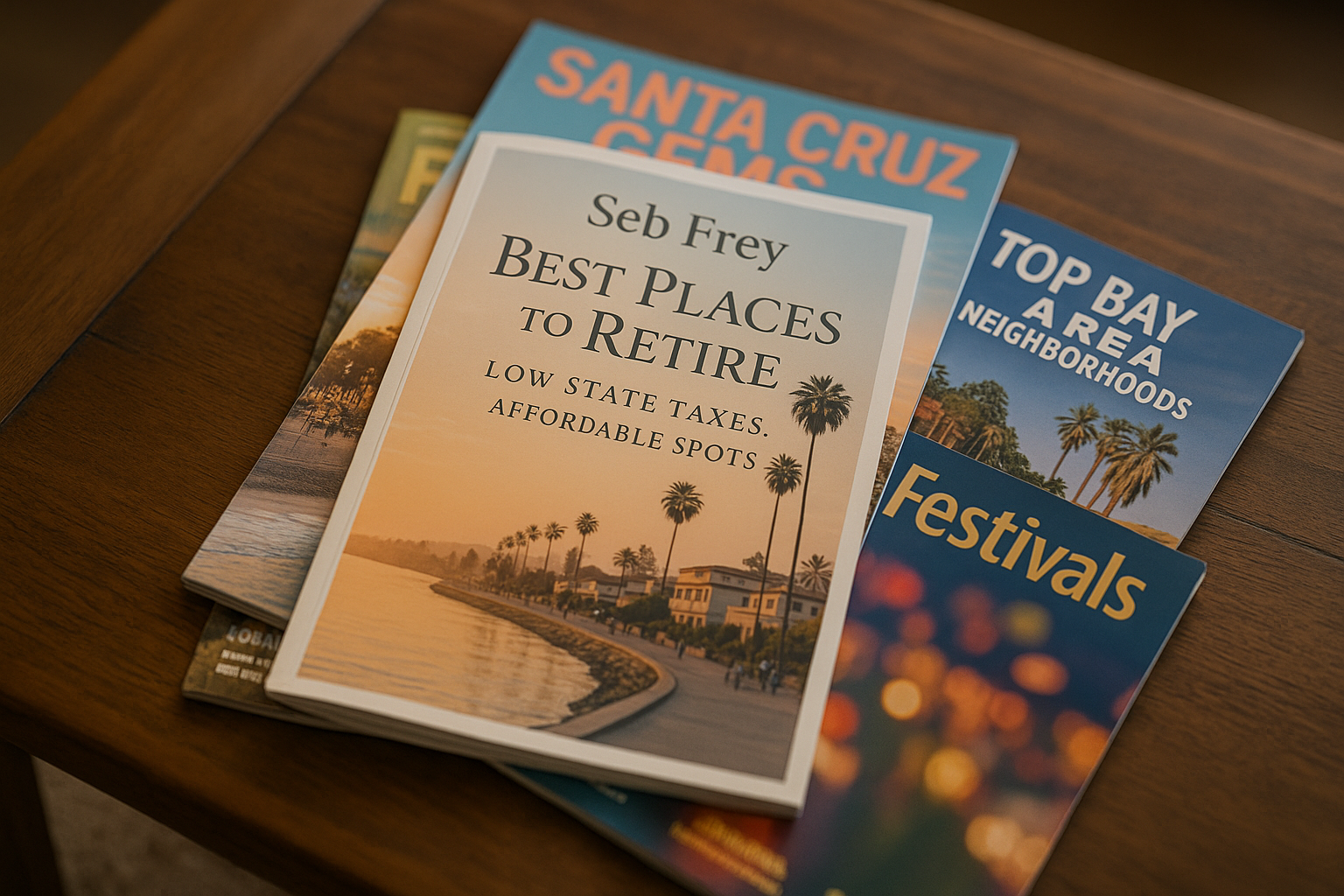The Bay Area Retirement Dilemma
There’s a lot to love about the Bay Area and Silicon Valley. The innovation, the culture, the sheer beauty – it’s a hard place to imagine leaving. But as retirement looms, a different kind of reality sets in, one often measured in dollars and cents. The Bay Area dream, with its stunning vistas and vibrant energy, comes with an equally stunning price tag, especially when it comes to housing and the general cost of living. That million-dollar-plus median home price? It’s a testament to the region’s desirability, but for many of us looking to stretch our nest eggs through potentially decades of retirement, it’s a formidable roadblock.
The thought of navigating retirement on a fixed income in one of the nation’s most expensive areas can transform excitement into anxiety. This isn’t just about affording a roof over your head; it’s about ensuring a quality of life where financial stress doesn’t overshadow the freedom retirement should offer. Many people feel “priced out” of the very place they helped build, prompting a search for a future where our savings can support not just survival, but genuine enjoyment and peace of mind.
So, when Forbes Magazine dropped their much-anticipated Best Places to Retire in 2025 list, my ears perked up. Forbes, as a reputable source, compared more than 950 locales across America, scrutinizing everything from housing costs and taxes to healthcare quality, air quality, crime rates, and even climate change and natural hazard risk. It’s the kind of comprehensive overview that can be an invaluable starting point.
However, as I quickly realized (and as you might too), a generic “best” list doesn’t always cut it for us Bay Area folks. We have… specific needs, a unique set of priorities forged by years of living in what is (or was, perhaps!) arguably one of the best places on Earth. The original Forbes online article proved elusive, but thankfully, detailed summaries and reports, particularly a comprehensive one from the Financial Express detailing the Forbes findings and other sources have allowed me to piece together the critical data.
That’s where this article comes in. I’ve dived into the research, cross-referencing the Forbes findings with what I know matters deeply to those of us considering a move from the Bay Area. It’s about more than just finding a cheaper place; it’s about finding a better fit for this next chapter of life. My goal? To filter Forbes’ top 25 picks through a distinctly Bay Area lens and handpick 10 cities that could genuinely be our perfect next chapter – places that offer not just financial relief but also a quality of life that allows us to thrive, all while keeping important connections to our California roots.
What We Bay Area Folks Really Need (And Want) in a Retirement Haven
Before I unveil my top 10, let’s talk about what “retiring well” looks like when you’re accustomed to the Bay Area but seeking a different path forward. Our checklist is a bit unique.
Let’s be honest, the number one item on my checklist – and likely yours – is a massive sigh of relief on the housing front. We’re not just looking for “cheaper”; we’re looking for a place where our hard-earned savings can buy a comfortable home and a lifestyle, not just a mortgage payment that keeps us up at night. The national median home price, as cited by Forbes in its 2025 analysis, hovers around $404,000. For us, any contender needs to be significantly below that, offering a substantial departure from Bay Area sticker shock. This financial breathing room is the cornerstone of a less stressful retirement.
Then there are taxes. After years of California’s tax rates, finding a state that’s kinder to retirees is a huge draw. I’m talking about a favorable state tax environment: ideally no state income tax at all, definitely no state tax on Social Security benefits, and advantageous treatment of other retirement income like pensions, 401(k), and IRA withdrawals. Every dollar saved from taxes is a dollar more for living, traveling, or spoiling the grandkids.
As we age, top-notch healthcare isn’t a luxury; it’s a necessity. My search prioritizes places with accessible, high-quality healthcare, which includes a good ratio of primary care physicians per capita and reputable hospitals or medical systems nearby. Peace of mind on this front is non-negotiable. We’re used to excellent medical facilities in the Bay Area, and while we might be moving for affordability, we can’t compromise on health.
Climate is personal, I get that. Some of us crave the eternal spring-like weather we’ve mostly enjoyed in the Bay Area, while others might be ready for the distinct beauty of four seasons, or perhaps the dry heat of a desert climate could be appealing. The Forbes list includes a variety, and my analysis will note what to expect, focusing on climates that generally support an enjoyable and active lifestyle without extreme, prohibitive conditions year-round.
Beyond the practicalities, we want a place where life is good. That means a sense of community, opportunities for recreation and cultural engagement, and feeling safe with low crime rates. Many of us are leaving a vibrant, intellectually stimulating environment, so the availability of cultural activities, perhaps linked to a university or a thriving arts scene, is a plus. I’m particularly interested in places Forbes notes as “bikeable” or “walkable,” as that speaks to an active, engaging lifestyle and potentially lower transportation costs. This isn’t just about saving money; it’s about a “value upgrade”—maintaining or even improving quality of life aspects even as costs decrease.
And finally, the big one for many of us: can we get back to the Bay Area easily and affordably? This is the umbilical cord. Whether it’s for visiting family (especially children and grandchildren), old friends, occasional business, or just a familiar fog-hug, access to a good airport with decent connections to San Francisco (SFO), Oakland (OAK), or San Jose (SJC) is a major factor in my rankings. This “travel back” factor is more than logistical; it’s emotional. It’s about not completely severing ties with a region that holds decades of personal history and significant relationships.
Decoding Forbes’ 2025 Retirement Hotspots: The Big Picture
Forbes cast a wide net in their 2025 search for the best retirement spots, comparing over 950 places across the United States. Their main yardsticks included things like affordable housing (a biggie for everyone, but especially us!), favorable tax environments for retirees, quality and availability of healthcare (like the number of primary care physicians), good air quality, low serious crime rates, and an increasingly important factor: climate change resilience and natural hazard risk.
They also looked for features that encourage an active and engaged lifestyle, such as walkability and bikeability. It’s a solid foundation for anyone looking to relocate, providing a vetted list of cities that excel in these general quality-of-life and financial metrics. The fact that Forbes explicitly considers climate change and natural hazard risk, excluding cities at “substantial risk as measured by FEMA” is particularly reassuring for those of us coming from California, where awareness of wildfires, drought, and seismic activity is a part of life.
Out of their top 25, I’ve put on my “Bay Area retiree” hat. My mission is to filter these already well-regarded locations through our specific lens. I’m looking for that sweet spot where Forbes’ general appeal meets our particular needs for significant cost savings (especially in housing – a key point being that 22 of Forbes’ 25 cities had median home prices at or below the national average which is already a huge step down from Bay Area prices), a friendly tax structure for California-grown nest eggs, great healthcare, a desirable lifestyle that doesn’t feel like a complete departure from the vibrancy we appreciate, and, crucially, a practical way to keep that connection to home. So, let’s get to my top 10 picks, carefully chosen and analyzed for you.
My Top 10 Retirement Destinations for Bay Area Consideration (from Forbes’ 2025 List)
After sifting through Forbes’ top 25 retirement destinations for 2025 with a Bay Area retiree’s priorities in mind—focusing on substantial cost-of-living relief, favorable tax structures, robust healthcare, an appealing lifestyle, and reasonable travel back to California—I’ve narrowed it down to these 10 cities. Each offers a unique blend of benefits that could make it an ideal new home.
1. Pittsburgh, Pennsylvania: My Bay Area Perspective – Why It Makes the Cut
When I first looked at Pittsburgh, what struck me was its incredible affordability combined with a rich urban fabric. This isn’t a sleepy town; it’s a historic city reinventing itself, full of rivers, colleges, and a surprising vibrancy.
- Forbes’ Stamp of Approval – The Key Highlights:
- Housing Scoop: Forbes notes a median home price of just $231,000. That’s a jaw-dropping 43% below the national median of $404,000! For Bay Area folks, this number represents a completely different financial reality, potentially allowing for a debt-free home purchase and significant leftover capital.
- Tax Talk: Pennsylvania offers a favorable tax climate for retirees. It has a flat 3.07% state income tax, but importantly, it excludes Social Security benefits and most other forms of retirement income from taxation. The one catch is a state inheritance tax that applies to heirs other than a spouse.
- Healthcare Check-up: Access to doctors is crucial, and Forbes highlights that Pittsburgh has an “excellent ratio of primary care doctors per capita”. The city is renowned for its medical centers, including those affiliated with the University of Pittsburgh and Carnegie Mellon University.
- Climate & Lifestyle Vibe: Expect four distinct seasons, including cold, snowy winters, which could be a change for Bay Area natives. However, Forbes also notes the city is “very bikeable and walkable” which promotes an active lifestyle. Pittsburgh is described as an “old guard western Pennsylvania city of 304,000 full of rivers…and colleges” suggesting a blend of history and youthful energy. A potential downside is that the city’s serious crime rate is above the national average.
- The Bay Area Connection – Getting Back Home:
- Thinking about those trips back? From Pittsburgh, you’d fly out of Pittsburgh International Airport (PIT). United Airlines offers nonstop flights to San Francisco (SFO) with a flight time of about 5 hours and 25 minutes. Other major carriers offer plenty of one-stop options as well. This makes visiting family or getting your Bay Area fix quite manageable.
- My Bottom Line for Bay Area Folks: For me, Pittsburgh shines because of its rock-bottom housing costs, strong healthcare, and surprisingly good retiree tax situation. If you can embrace four seasons and are looking for an urban environment with character, Pittsburgh offers incredible value. The ability to be “walkable” and “bikeable” also means potentially lower transportation costs and more community engagement, which can be vital for staving off isolation in a new city.
2. San Antonio, Texas: My Bay Area Perspective – Why It Makes the Cut
San Antonio immediately grabs attention with its affordability and vibrant Texan culture. It’s a large, diverse city offering a lot of bang for your retirement buck.
- Forbes’ Stamp of Approval – The Key Highlights:
- Housing Scoop: Forbes lists San Antonio’s median home price at an astonishing $252,000, which is 38% below the national median. This is a massive difference from Bay Area prices and even significantly lower than many other “affordable” spots.
- Tax Talk: Texas is famously tax-friendly for retirees: there is no state income tax or state estate tax. This means Social Security, pensions, and 401(k)/IRA withdrawals are not taxed at the state level, a huge win for stretching retirement funds.
- Healthcare Check-up: Healthcare access in San Antonio is reported by Forbes as being “close to the national average” in terms of primary care physicians per population. As a major city, it has numerous large hospital systems.
- Climate & Lifestyle Vibe: Expect hot, humid summers, a common trait in Texas. Winters are generally mild. Forbes notes the city is “somewhat bikeable” but “not very walkable”. A significant con is that the serious crime rate is above the national average. However, as the nation’s seventh-largest city, it offers a wealth of cultural attractions, history (The Alamo, River Walk), and dining.
- The Bay Area Connection – Getting Back Home:
- San Antonio International Airport (SAT) serves the city. United Airlines offers nonstop flights to San Francisco (SFO) with a flight time of around 3 hours and 42 minutes. Other carriers provide ample connecting flights. This makes travel back to the Bay Area relatively quick and convenient.
- My Bottom Line for Bay Area Folks: San Antonio is a compelling option due to its extremely low housing costs and zero state income tax. If you’re seeking a large city with a distinct cultural flavor and can handle the summer heat, the financial advantages are hard to ignore. The ease of direct flights back to California is a significant bonus.
3. Apache Junction, Arizona: My Bay Area Perspective – Why It Makes the Cut
For those drawn to desert landscapes and sunshine, Apache Junction, on the eastern outskirts of Phoenix, offers a compelling mix of outdoor access and affordability.
- Forbes’ Stamp of Approval – The Key Highlights:
- Housing Scoop: The median home price here is $382,000, about 5% below the national median. While not as dramatically low as Pittsburgh or San Antonio, it’s still a world away from Bay Area prices.
- Tax Talk: Arizona boasts a good retiree tax climate. There’s a flat state income tax of 2.5%, Social Security benefits are exempt, and there’s no state estate or inheritance tax.
- Healthcare Check-up: Forbes notes an “above-average ratio of primary care physicians per capita” which is reassuring. Proximity to the larger Phoenix metro also means access to specialized care.
- Climate & Lifestyle Vibe: Expect a scenic dry climate with very hot summers. Winters are mild and sunny. It’s an outdoorsy community up against the Superstition Mountains, making it great for hiking. Forbes mentions it’s “somewhat bikeable” but “not very walkable” and that air quality can be a problem. The violent crime rate is above the national average.
- The Bay Area Connection – Getting Back Home:
- Apache Junction is about 35 miles east of Phoenix Sky Harbor International Airport (PHX). PHX is a major hub offering numerous daily nonstop flights to SFO, OAK, and SJC on carriers like Southwest, United, American, and Frontier, with flight times typically between 1 hour 55 minutes and 3 hours. This is excellent connectivity.
- My Bottom Line for Bay Area Folks: If you love the desert, want significant tax relief, and prioritize easy flights back to California, Apache Junction is a strong contender. The trade-offs are the intense summer heat and higher crime rates, but the scenic beauty and outdoor lifestyle will appeal to many.
4. Tucson, Arizona: My Bay Area Perspective – Why It Makes the Cut
Tucson offers another Arizona option, distinct from Phoenix, with its own unique Southwestern charm, a major university, and a lower cost of living.
- Forbes’ Stamp of Approval – The Key Highlights:
- Housing Scoop: The median home price in Tucson is around $329,000, approximately 19% below the national median [ (2022 data shows $278k)]. This provides substantial savings compared to California.
- Tax Talk: Like Apache Junction, Tucson benefits from Arizona’s retiree-friendly tax policies: a 2.5% flat state income tax, no tax on Social Security, and no state estate or inheritance tax.
- Healthcare Check-up: Forbes indicates Tucson has a “strong healthcare system with a good supply of primary care doctors,” partly thanks to the University of Arizona.
- Climate & Lifestyle Vibe: Expect a sunny climate with intense summer heat. The city is home to the University of Arizona, lending it a vibrant, intellectual atmosphere with a notable arts and culture scene. Forbes notes it’s “very bikeable”. However, the serious crime rate is above the national average.
- The Bay Area Connection – Getting Back Home:
- Tucson International Airport (TUS) serves the city. United Airlines offers nonstop flights to San Francisco (SFO) with a flight time of about 2 hours and 13 minutes. Other airlines provide ample one-stop connections. This makes trips back to the Bay Area quite convenient.
- My Bottom Line for Bay Area Folks: Tucson offers a compelling blend of affordability, a favorable tax environment, cultural amenities from a university town, and direct flights to the Bay. It’s a solid choice for those who appreciate a desert climate and a lively city feel, though the summer heat and crime rate are factors to weigh.
5. Sioux Falls, South Dakota: My Bay Area Perspective – Why It Makes the Cut
Sioux Falls might be a surprise for some, but its financial advantages for retirees are hard to overlook, coupled with a reputation for a good quality of life.
- Forbes’ Stamp of Approval – The Key Highlights:
- Housing Scoop: The median home price is $326,000, which is 19% below the national median. This offers significant affordability.
- Tax Talk: South Dakota is one of the most tax-friendly states for retirees: there is no state income tax, no state estate tax, and no state inheritance tax. This is a massive plus.
- Healthcare Check-up: Forbes highlights “excellent healthcare access” and “very good air quality”.
- Climate & Lifestyle Vibe: Winters are cold, which is a significant consideration for those used to milder Bay Area weather. However, the city is noted for being “very bikeable”. It’s South Dakota’s largest city and has a growing reputation for a friendly community and good amenities. Forbes does not specify crime details in the summary, but from a previous Forbes list mentions a “low crime rate” for active seniors.
- The Bay Area Connection – Getting Back Home:
- Sioux Falls Regional Airport (FSD) provides air service. Flights to San Francisco (SFO) typically involve one stop (often via Denver, Chicago, or Minneapolis) and take around 5 to 6 hours. While not direct, the connections are frequent.
- My Bottom Line for Bay Area Folks: If maximizing your retirement income through extremely favorable tax laws and affordable housing is a top priority, and you don’t mind cold winters, Sioux Falls is a standout. The excellent healthcare is another major draw. The one-stop flights are manageable for maintaining Bay Area ties.
6. College Station, Texas: My Bay Area Perspective – Why It Makes the Cut
Home to Texas A&M University, College Station offers the vibrancy of a college town combined with Texas-sized affordability and tax benefits.
- Forbes’ Stamp of Approval – The Key Highlights:
- Housing Scoop: The median home price is $347,000, about 14% below the national average. This is a comfortable level of affordability.
- Tax Talk: Like San Antonio, College Station benefits from Texas’s lack of state income or estate tax. This is a significant financial advantage for retirees.
- Healthcare Check-up: Forbes notes a “strong healthcare system with abundant doctors” and “good air quality”.
- Climate & Lifestyle Vibe: Summers are hot and humid, a typical Texas feature. The city has a “very low serious crime rate” and a “good economy,” and is “very bike-friendly”. Walkability is limited. The university provides a hub for cultural and sporting events. The “college town” attribute often implies a more stable local economy and a community that’s used to newcomers, which can be a plus.
- The Bay Area Connection – Getting Back Home:
- Easterwood Airport (CLL) serves College Station. American Airlines offers flights to San Francisco (SFO) typically with one stop (often through Dallas/Fort Worth), with total travel times around 6 to 7 hours.
- My Bottom Line for Bay Area Folks: College Station is attractive for its excellent tax environment, affordable homes, low crime, and the amenities of a major university town. If you’re comfortable with Texas summers and a one-stop flight to California, it’s a strong contender.
7. Lawrence, Kansas: My Bay Area Perspective – Why It Makes the Cut
A quintessential college town (University of Kansas), Lawrence offers a lively atmosphere, good affordability, and a comfortable lifestyle.
- Forbes’ Stamp of Approval – The Key Highlights:
- Housing Scoop: The median home price is $318,000, which is 21% below the national median.
- Tax Talk: Kansas has an “average” state tax climate for retirees according to Forbes. Social Security benefits are no longer taxed, but other retirement income can be taxed at rates up to 5.58% for higher-income couples.
- Healthcare Check-up: Forbes highlights a “high number of primary care doctors” and “good air quality”.
- Climate & Lifestyle Vibe: The climate is generally comfortable with four seasons. A big plus is that the “serious crime rate is well below the national average”. The city is “very bike-friendly” and offers a lively cultural and academic atmosphere due to the university.
- The Bay Area Connection – Getting Back Home:
- Lawrence is about 40 miles west of Kansas City. Kansas City International Airport (MCI) would be the primary airport. United offers nonstop flights to San Francisco (SFO) taking about 4 hours, and many other airlines offer frequent one-stop options. This makes travel relatively convenient.
- My Bottom Line for Bay Area Folks: Lawrence offers a great blend of affordability, a safe and active college-town environment, and decent travel connections. While Kansas taxes aren’t as low as some other states on this list, the overall package, especially the lower crime rate and comfortable climate, is appealing.
8. Lincoln, Nebraska: My Bay Area Perspective – Why It Makes the Cut
As Nebraska’s capital and another vibrant college town, Lincoln stands out for its very affordable housing and an improving tax picture for retirees.
- Forbes’ Stamp of Approval – The Key Highlights:
- Housing Scoop: Lincoln boasts a median home price of $283,000, a significant 30% below the national average. This is one of the most affordable options on the Forbes list.
- Tax Talk: Forbes notes the retiree tax environment is “still in transition” but improving. The marginal income tax rate is 5.01% for couples over $48,250 (peaking at 5.2%), and Social Security benefits are still partially taxed. There is a state inheritance tax, though exemptions are available.
- Healthcare Check-up: Healthcare access is “adequate,” with a “fair number of primary care physicians per capita” and “good air quality”.
- Climate & Lifestyle Vibe: Expect a four-season climate, which can include cold winters and hot summers. Forbes describes Lincoln as “very bikeable” and offering a “somewhat walkable lifestyle”. It has a good economy and a relatively moderate vulnerability to natural hazards.
- The Bay Area Connection – Getting Back Home:
- Lincoln Airport (LNK) serves the city. United Airlines offers flights to San Francisco (SFO), typically with one stop (often via Denver), with travel times around 5 to 6 hours.
- My Bottom Line for Bay Area Folks: Lincoln’s primary draw is its exceptional housing affordability. If you’re looking to maximize how far your housing dollar stretches and are okay with a continental climate and a tax situation that’s good but not perfect, Lincoln is worth a serious look. The “very bikeable” aspect also points to an easier, potentially lower-cost way to get around.
9. Iowa City, Iowa: My Bay Area Perspective – Why It Makes the Cut
A highly regarded Midwestern college town (University of Iowa), Iowa City offers a strong combination of affordability, excellent healthcare, and a favorable tax environment for retirees.
- Forbes’ Stamp of Approval – The Key Highlights:
- Housing Scoop: The median home price in Iowa City is $289,000, a compelling 28% below the national average.
- Tax Talk: Iowa has a good state tax climate for retirees. The state income tax is a flat 3.8%, and importantly, there are no state taxes on Social Security or other retirement income. There is also no state estate or inheritance tax. This is a very attractive profile for those with California-sized retirement accounts.
- Healthcare Check-up: Forbes highlights “excellent healthcare access” and “very good air quality”. The University of Iowa includes a major teaching hospital.
- Climate & Lifestyle Vibe: Expect cold and sometimes harsh winters. However, the city is noted as being “among the most bikeable cities in the region” and “somewhat walkable”. It’s a UNESCO City of Literature, indicating a rich cultural scene. The serious crime rate is at the national average.
- The Bay Area Connection – Getting Back Home:
- The Eastern Iowa Airport (CID) in Cedar Rapids is the closest major airport, about a 30-40 minute drive. From CID, flights to San Francisco (SFO) typically involve one stop (often via Chicago or Denver) and take approximately 6 to 7 hours.
- My Bottom Line for Bay Area Folks: Iowa City scores high on affordability, retiree tax-friendliness, and healthcare. The cultural amenities of a university town are a big plus. If you can embrace true four-season weather, including cold winters, this is a financially smart and enriching option.
10. Pasco, Washington: My Bay Area Perspective – Why It Makes the Cut
Located in Washington’s Tri-Cities region, Pasco offers the significant benefit of no state income tax, along with a comfortable climate and good healthcare access.
- Forbes’ Stamp of Approval – The Key Highlights:
- Housing Scoop: The median home price in Pasco is $406,000, which is slightly above the national median by about 1%. While not as low as many others on this list, it’s still a dramatic saving compared to the Bay Area, and Washington’s other benefits might offset this.
- Tax Talk: Washington State has no state income tax, which is a major draw for retirees. However, it does impose a state estate tax and a 7% excise tax on investment gains above a certain threshold (currently $270,000).
- Healthcare Check-up: Forbes notes a “strong supply of primary care physicians” and “good air quality”.
- Climate & Lifestyle Vibe: Expect a “very comfortable, sunny climate”. The serious crime rate is below the national average. Forbes mentions it’s “not especially walkable or bikeable,” which is a consideration for an active lifestyle without a car.
- The Bay Area Connection – Getting Back Home:
- Tri-Cities Airport (PSC) serves Pasco. United Airlines and Alaska Airlines offer nonstop flights to San Francisco (SFO) with a quick flight time of around 2 hours to 2 hours and 10 minutes. This is excellent connectivity.
- My Bottom Line for Bay Area Folks: Pasco’s biggest appeal is Washington’s no-income-tax status and the quick, direct flights back to the Bay Area. The sunny climate is also a plus. The median home price is higher than other top contenders, but for those prioritizing no income tax and easy travel, it’s a very strong option.
Quick Comparison: My Top 10 At-a-Glance for Bay Area Retirees
To help you see how my top 10 stack up on the factors most critical for us Bay Area folks, I’ve put together this quick comparison table. Remember, the national median home price noted by Forbes is around $404,000 – keep that and our Bay Area prices in mind as you scan these numbers!
| City, State | Forbes Median Home Price | State Retiree Tax Climate Summary | Healthcare Access (Forbes Note) | General Climate Note | Ease of Travel to Bay Area (Airport & Typical Flight) |
| Pittsburgh, PA | $231,000 | SS & most retire income exempt; flat 3.07% IT; inherit tax | Excellent ratio of docs | Four seasons, cold winters | PIT: Nonstop to SFO (~5.5 hrs) |
| San Antonio, TX | $252,000 | No state income/estate tax | Near nat’l avg docs | Hot summers, mild winters | SAT: Nonstop to SFO (~3.7 hrs) |
| Apache Junction, AZ | $382,000 | 2.5% flat IT; SS exempt; no estate tax | Above-avg ratio of docs | Dry, very hot summers | PHX (35mi): Nonstop to SFO/OAK/SJC (~2-3 hrs) |
| Tucson, AZ | $329,000 | 2.5% flat IT; SS exempt; no estate tax | Good supply of docs | Sunny, intense summer heat | TUS: Nonstop to SFO (~2.2 hrs) |
| Sioux Falls, SD | $326,000 | No state income/estate/inheritance tax | Excellent access | Cold winters, four seasons | FSD: 1-stop to SFO (~5-6 hrs) |
| College Station, TX | $347,000 | No state income/estate tax | Abundant docs | Hot summers, humid | CLL: 1-stop to SFO (~6-7 hrs) |
| Lawrence, KS | $318,000 | SS exempt; other retire income taxed | High number of docs | Comfortable, four seasons | MCI (40mi): Nonstop/1-stop to SFO (~4+ hrs) |
| Lincoln, NE | $283,000 | Improving; SS partly taxed; inherit tax | Adequate docs | Four seasons, extremes | LNK: 1-stop to SFO (~5-6 hrs) |
| Iowa City, IA | $289,000 | Flat 3.8% IT; SS & retire income exempt; no estate tax | Excellent access | Cold winters, four seasons | CID (~35min): 1-stop to SFO (~6-7 hrs) |
| Pasco, WA | $406,000 | No state income tax; estate/invest tax | Strong supply of docs | Comfortable, sunny | PSC: Nonstop to SFO (~2 hrs) |
This table helps to directly compare these excellent options based on some of the most pressing concerns for those of us looking to make a smart retirement move from the expensive Bay Area. It highlights that significant financial relief is possible without necessarily sacrificing access to good healthcare or the ability to visit loved ones back in California.
Finding Your Perfect Bay Area Escape Hatch: My Parting Advice
I’ve shared my homework and my top 10 picks based on what I believe resonates most with us Bay Area folks looking for a change. This journey of research has certainly opened my eyes to the incredible possibilities that lie beyond California’s borders. But as financial planners often wisely note, the “goal behind the goal” is deeply personal. What makes one person content and fulfilled in retirement might not suit another perfectly. Your priorities, your family situation, your health, and your personal dreams for this next chapter must be the ultimate guide.
Therefore, no amount of research, not even my brilliant analysis (if I do say so myself!), can replace experiencing a place firsthand. This is a recurring theme from relocation experts: spend time there – a few weeks, a season if you can – before you even think about calling the movers. Renting initially is an incredibly smart move, allowing you to test the waters of a new community, climate, and lifestyle without the commitment of buying a home immediately. This trial period can save a lot of heartache and expense down the road, as some who move solely for cost discover that other quality-of-life factors don’t align with their expectations.
Use this article as your launchpad. Dive deeper into the locations that pique your interest. Talk to a financial advisor who understands the complexities of out-of-state moves, particularly the tax implications for your specific retirement income streams. Explore online forums, connect with people who’ve made similar moves from California, and try to get a genuine feel for the neighborhoods and the local culture. Remember to be kind to yourself during this process; downsizing and relocating can be emotionally and physically demanding. It’s not just a financial transaction but a significant life transition.
My Final Thoughts: Your Next Chapter is Calling
Leaving the Bay Area is a big decision, no doubt. It’s a place that holds memories, relationships, and for many of us, a significant part of our identity. But as my research into Forbes’ list and the realities of these diverse American cities shows, there are some truly fantastic, affordable, and welcoming places out there waiting to be discovered. Your dream retirement, one that is free from the Bay Area’s intense financial pressures but rich in what truly matters – health, happiness, community, and new experiences – is absolutely within reach. The act of researching and planning this new adventure can itself be empowering, offering a sense of control and optimism.
So, take these ideas, start your own exploration, and perhaps plan those crucial exploratory trips. Your next great adventure, a fulfilling and financially secure retirement, might just be a U-Haul away. The adventure awaits!
Gracious Homes at The Villages in San Jose
2
3
4
5
6
7
8
9
10
11
12
13
14
15
16
17
18
19
20
21
22
23
24
25











